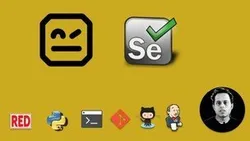
Software Testing Simple (Software Quality Assurance QA) 
This course provides an introduction to software quality assurance and testing, giving an overview of the roles and responsibilities of a QA professional. It is designed to be the simplest and most practical way to learn the basics of software testing. ▼
ADVERTISEMENT
Course Feature
![]() Cost:
Cost:
Free
![]() Provider:
Provider:
Udemy
![]() Certificate:
Certificate:
Paid Certification
![]() Language:
Language:
English
![]() Start Date:
Start Date:
On-Demand
Course Overview
❗The content presented here is sourced directly from Udemy platform. For comprehensive course details, including enrollment information, simply click on the 'Go to class' link on our website.
Updated in [March 06th, 2023]
This course, Software Testing Simple (Software Quality Assurance QA), is designed to provide an introduction to software testing and quality assurance. It is the perfect starting point for those looking to enter the field of software testing and quality assurance. The course covers topics such as software development life cycle (SDLC), testing definition, defects (bugs), types of testing, how to capture screenshots, bug triage, severity and priority, test cases, test plans, smoke, sanity and regression testing, how to test on mobile devices, modern browsers and segmentation, how to test Android and iOS apps without a device, positive and negative testing, boundary value analysis, equivalence partitioning testing, web architecture, back-end and front-end testing, how to debug front-end or back-end issues, builds and releases, deployment, release, user acceptance testing (UAT), QA interview, QA resume screening, QA phone screening, tell me about yourself story, tell me about your project, QA technical interview questions, and QA personality interview questions. Test automation is not covered in this course.
This course is designed to provide an understanding of what software testing is and how to perform it in a real world. It will also provide an understanding of how to use JIRA and Zephyr tools with live project demonstration. It will explain what test cases and bugs (defects) are and how to write them. It will also provide an understanding of the different types of testing with real examples (Apple, Kylie Jenner, Hawaii State, Chase, Home Depot, LA Times and other real ones). It will also provide an understanding of the software development life cycle (SDLC) with a Simpsons example. Finally, it will provide a complete knowledge of the QA process starting from requirement gathering to project delivery.
This 3-hour course is the easiest practical testing course on the market and will provide a great introduction to the world of software testing and quality assurance. It is the perfect starting point for those looking to enter the field of software testing and quality assurance. With the increasing demand for software testers and competitive compensation, this course is the perfect way to get into the tech world without learning programming languages.
By the end of this course, you will have a complete understanding of software testing and quality assurance and be able to apply it to real-world scenarios. You will also have the knowledge and skills to write test cases, debug issues, and prepare for a QA interview.
So, if you are looking to get into the tech world and become a software tester, this course is the perfect starting point. Sign up today and start your journey into the world of software testing and quality assurance!
[Applications]
After completing this course, students will have a comprehensive understanding of software testing and the QA process. They will be able to apply their knowledge to real-world scenarios, such as writing test cases and bugs, using JIRA and Zephyr tools, and understanding the software development life cycle. Additionally, they will have the skills to apply for a QA job, including how to prepare for an interview, write a resume, and apply on LinkedIn and Glassdoor. Finally, they will have a better understanding of the different types of testing, such as UI, functional, compatibility, localization, performance, usability, security, and ad-hoc testing.
[Career Paths]
Recommended career paths for learners of this course include:
1. Software Quality Assurance (QA) Analyst: As a QA Analyst, you will be responsible for ensuring the quality of software products by testing them for bugs and other issues. You will also be responsible for creating test plans, writing test cases, and executing tests. The demand for QA Analysts is increasing as more companies are recognizing the importance of quality assurance in software development.
2. Test Automation Engineer: As a Test Automation Engineer, you will be responsible for developing and maintaining automated test scripts to ensure the quality of software products. You will also be responsible for creating and executing automated tests, analyzing test results, and reporting any issues. The demand for Test Automation Engineers is increasing as more companies are recognizing the importance of automation in software testing.
3. Software Tester: As a Software Tester, you will be responsible for testing software products for bugs and other issues. You will also be responsible for creating test plans, writing test cases, and executing tests. The demand for Software Testers is increasing as more companies are recognizing the importance of quality assurance in software development.
4. Software Quality Assurance (QA) Manager: As a QA Manager, you will be responsible for overseeing the quality assurance process for software products. You will also be responsible for creating test plans, writing test cases, and executing tests. The demand for QA Managers is increasing as more companies are recognizing the importance of quality assurance in software development.
[Education Paths]
Recommended degree paths for software testing include:
1. Bachelor's Degree in Computer Science: This degree provides a comprehensive overview of computer science fundamentals, including programming, software engineering, and software testing. It also covers topics such as data structures, algorithms, and operating systems. This degree is ideal for those looking to pursue a career in software testing, as it provides the necessary skills and knowledge to be successful. Additionally, the degree provides a strong foundation for further study in software engineering and software testing.
2. Master's Degree in Software Testing: This degree provides a more in-depth look at software testing, including topics such as test automation, test design, and test management. It also covers topics such as software quality assurance, software development life cycle, and software testing methodologies. This degree is ideal for those looking to specialize in software testing and become a software testing expert.
3. Doctorate Degree in Software Testing: This degree provides an even more comprehensive look at software testing, including topics such as software testing research, software testing theory, and software testing tools. It also covers topics such as software testing standards, software testing metrics, and software testing best practices. This degree is ideal for those looking to become a software testing expert and pursue a career in software testing research.
The development trends in software testing are moving towards automation and artificial intelligence. Automation is becoming increasingly important in software testing, as it allows for faster and more accurate testing. Additionally, artificial intelligence is being used to automate more complex tasks, such as test case generation and bug detection. As these technologies become more advanced, software testing will become more efficient and accurate.
Pros & Cons

Great deal of information

Clear explanation

Structured overview

Useful for new learners

Well organized

Good explanations and tips

Many sections had ending cuts

Appears more like short overview
Course Provider

Provider Udemy's Stats at AZClass
Discussion and Reviews
0.0 (Based on 0 reviews)
Explore Similar Online Courses

Facebook Ads: Create High Converting Sales Funnel

CBT Techniques For Anger Management

Python for Informatics: Exploring Information

Social Network Analysis

Introduction to Systematic Review and Meta-Analysis

The Analytics Edge

DCO042 - Python For Informatics

Causal Diagrams: Draw Your Assumptions Before Your Conclusions

Whole genome sequencing of bacterial genomes - tools and applications

Boost Your Game Performance in Unity 3D

ISTQB Certified Tester Foundation Level Training (CTFL)

Robot Framework RIDE & Selenium - Step by Step for Beginners
 Related Categories
Related Categories
 Popular Providers
Popular Providers
Quiz
 Submitted Sucessfully
Submitted Sucessfully
1. What is the main purpose of software testing?
2. What is the most common type of software testing?
3. What is the most important step in the software development life cycle?
4. What is User Acceptance Testing (UAT)?
Correct Answer: It is a type of testing to verify if the system meets the requirements of the user.


Start your review of Software Testing Simple (Software Quality Assurance QA)